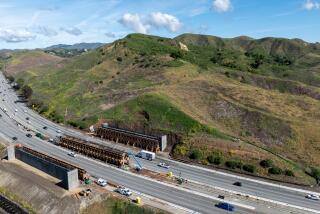Environmental coalition wants to save whales by reducing ships’ speed in marine sanctuaries
A coalition of environmental groups is asking the federal government to require ships traveling through California’s marine sanctuaries to slow down to avoid fatal collisions with whales, a problem they say has climbed to “unsustainable levels.”
Four groups filed a petition Monday asking the U.S. Department of Commerce to establish a 10-knot limit for large commercial vessels traveling through California’s four National Marine Sanctuaries in the Channel Islands, Monterey Bay, Gulf of the Farallones and Cordell Bank. Some freighters travel through those waters at more than twice that speed.
Nearly 50 whales have been hit by ships off the California coast in the last decade, according to experts, who believe the number is probably much higher because many accidents go unreported.
Shipping groups say a speed limit would greatly delay cargo reaching port and more than double the time it takes the fastest vessels to travel through the sanctuaries.
The petition from the environmental groups is meant to prod the federal government to take steps to deal with the growing concern. Some of the most heavily used shipping lanes in and out of ports in Los Angeles, Long Beach and San Francisco Bay run through the migratory paths and feeding areas of endangered whales.
In the 61-page document, the Environmental Defense Center, Center for Biological Diversity, Friends of the Earth and Pacific Environment say a speed limit would help protect endangered blue, humpback and fin whales from being run over by big ships.
“The overlap of these shipping lanes with California’s national marine sanctuaries puts sanctuary wildlife at great risk,” the petition reads. “While we cannot likely change the behavior of whales and other species so as to avoid ship strikes, we can and must regulate vessel practices to minimize this risk.”
Slower speeds would give whales more time to detect approaching ships and would lower the chances that injuries would become fatal if they are hit, the groups argue. A speed limit also would cut back on air pollution, and greenhouse gas emissions and underwater noise, which can harm whales.
In a statement, the National Oceanic and Atmospheric Administration, a branch of the Department of Commerce that oversees national marine sanctuaries and endangered marine species, said it is also concerned with ship strikes to whales and would review the petition.
Shipping groups said a speed limit may not make it any safer for whales and has suggested realigning shipping routes as an alternative.
“It’s just premature to assume that slowing vessel speed is the solution to the ship-whale interaction issue,” said T.L. Garrett, vice president of the Pacific Merchant Shipping Assn., a trade group representing ocean carriers that dock at West Coast ports. Where possible, vessels would probably navigate around the sanctuaries to avoid the restrictions, he said.
Four blue whales were struck and killed by vessels in 2007 near the Channel Islands National Marine Sanctuary, prompting NOAA to designate shipping lanes from Point Conception to Point Dume a “whale advisory zone.”
Since then, the agency has conducted aerial surveys of the area and broadcast seasonal advisories to ship captains traveling through the channel, suggesting that they limit their speed to 10 knots — roughly 11.5 mph — to avoid hitting whales when they’re in the Santa Barbara Channel in high concentrations, usually from May to December.
Because the advisories are voluntary, environmental groups say, they have gone largely unheeded. Shipping groups said most vessels have not lowered their speeds.
A mandatory speed limit would not be the first. A seasonal 10-knot speed limit is already in place on large ships traveling through key areas off the U.S. East Coast to protect endangered North Atlantic right whales.
Environmentalists cite more recent fatalities, including at least five documented in 2010 alone. A fin whale was wedged on the bow of a cargo ship when it arrived at the Port of Oakland last year and a humpback whale washed ashore last month in San Pedro with apparent injuries from a large ship’s propeller.
NOAA officials said they are still studying whether the collisions significantly threaten West Coast populations of endangered species like the blue whale.
“We just don’t know yet,” said Chris Mobley, superintendent of the Channel Islands National Marine Sanctuary. “Even though they’re large animals, it’s a big ocean out there.”
More to Read
Sign up for Essential California
The most important California stories and recommendations in your inbox every morning.
You may occasionally receive promotional content from the Los Angeles Times.











